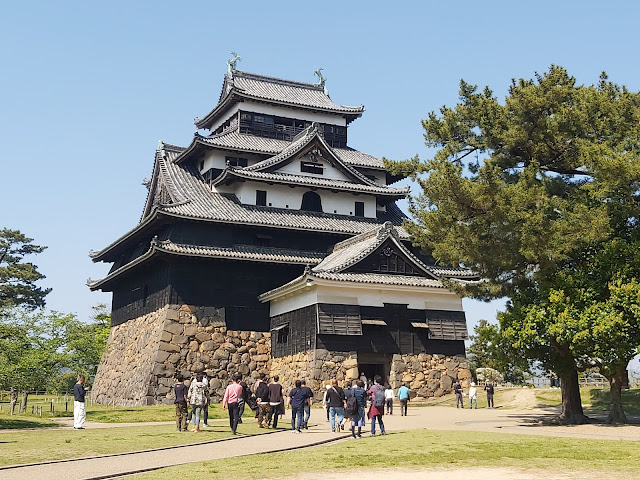Stage 2: Cycling along the Sea of Japan.
Quick Note:
It was a great first experience of cycling up Japan’s West Coast after arriving in Sakaiminato.
I have never encountered more friendly, helpful and polite people in my travels. Cycling I found is the safest ever, as car operators are extremely cautious.
Hopefully this will continue.
After arrival in the morning, it was an efficient transition through passport control, where I received a 3 month stay.
At customs, even my bicycle tires got cleaned.
(sorry no pictures allowed)
 |
| Leaving from the ferry Terminal |
It was a short first ride to the town of Matsue.
Kristie also joined me on those first few days of sightseeing.
 |
| Nice coffee roasting cafe |
Matsue Castle was first on the list, constructed from 1607- 1611.
After walking the castle grounds, a relaxing 45 minute moat boat ride
was a good recipe for the tired legs.
All boat operators are retired volunteers and sing their own songs.
On the way along the coast, soon was the town of Katoura with Japanese
style streets. Narrow, grey and seldom people about.
It was lively though at the Hazzy Star Cafe.
No Coffee, but tasty GinTonics and super friendly bar staff.
Almost 50% in Japan follow Buddhism and a statue is never far away.
The Tottori Sand Dune is the largest in Japan.
 |
| 14km long, 2.4km wide and up to 50m high |
At the Sand Museum, sculptures from artists
from all over the world can be seen.
Riding continued along a winding and hilly coastal road.
and through ever cracking bamboo forests.
Not always everything goes as smoothly as anticipated.
Closed roads require long detours sometimes.
Komoot, unfortunately doesn’t register road closures!
Back on the main road, requires a never ending amount of tunnels to be passed.
Some are rather narrow and uneasy, some are luxurious with a separate line.
It’s Golden Week (3 public holidays) and rather crowded in popular places.
Camping out is a must, as most accommodations are booked out.
Love my new Nemu Tensor insulated air mattress.
Comfy and fills up with the air sack effortlessly.
Wasn't expecting this town.
And back to the coast.
 |
| Harbour Protector |
 |
| Wakasa Beach |
On the go lunch in one of many convenient stores.
Some hill crossings followed old railway lines and tunnels.
This is always a good option, as it is an ever gentle grade.
Depending on the length of the tunnel,
it can be an up to 10 minutes wait, as they are single lane.
Some are without light and pitch black.
Some rough camping.
Never get tired riding through rice paddies.
Mansions in the middle of paddy fields.
Back and forth, from paddies to coast.
Riding has been comfortable, even through towns.
Still amazed how courteous Japanese drivers are.
30 to 40% of cars in Japan are small narrow box KEI cars.
They are cheap, insurance and maintenance friendly,
plus they can pass in their narrow village streets.
I like them, because it leaves more space between metal & lycra.
The night to remember campsite from under the bridge,
where sleep was hard to come by.
It was a noisy night, with frogs croaking in rice paddies late
into the night, water rushing from paddies and traffic across the bridge above.
The birds started their calls rather early, since sunrise was at 4:50.
Looking forward to a hotel bed!
 |
| The campsite was down below. |
Buried Forest Museum in Uozu
Before a long day on the road, a Japanese breakfast provides a good basis.
 |
| Turned out, them fellows weren't my favorites! |
Last views of the Sea of Japan, before turning toward
Tokyo on the Pacific side.
 |
| Rev. Walter Weston |
Itoigawa was the turning point to change direction
across the mountainous center.
In Japan I use Komoot for navigation
and is great at plotting routes through villages and less populated areas.
Google Maps is better at finding locations on a local level.














































